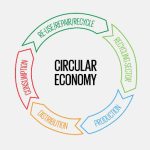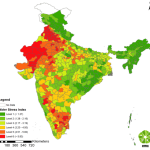Environmental Impact Assessment (EIA) has been a celebrated tool, widely accepted across the world for sustainable development following a precautionary principle. But in its 50 years of existence, effectiveness of EIA has remained in question. Some believe that requirement of EIA has influenced the project concept, its siting, design and operations and they have few good stories to share where EIA added a value. A large number of people however argue that EIA studies are carried out essentially to obtain the Environmental Clearance (EC). Unfortunately, the implementation and monitoring of the agreed Environmental Management Plans (EMP) have remained weak.
One of the reasons for this apathy is the poor understanding of the relationship between environment, economics and livelihoods at the government bodies as well as at the business or the private sector. The pace and pressure on economic development is not giving us time enough or a respite to rethink. Corruption and pollution around us have shaken up the foundations of transparency, ethics and equity. No wonder, EIA has remained today more as a perfunctory tool.
“If this is the case, then why are we proposing 2020 EIA Notification? Is the proposed Notification solving these problems?” My Professor Friend asked me this question.
“Well Professor, all systems need to be updated. It is now more than 14 years that the last EIA Notification was introduced”. I answered in a tone of matter of fact.
There have been so many amendments to the 2006 EIA Notification in the past several years, that understanding what is currently applicable has often been a challenge.
These numerous OMs (Office Memorandums) have been now well reflected and consolidated in the 2020 Draft Notification. I thought that this work itself deserves congratulations to the Ministry.
But Professor raised a red flag.
He said the only worry was that in such an exercise of consolidation, OMs that were meant to resolve certain irregularities in the past, especially on the violations of EC, were now brought in as applicable to all future cases of violations i.e. violations on EC will now be allowed, albeit with a penalty.
He was right. This reminded me of the amnesty scheme released time to time for the Income Tax defaulters to regularize their misdeeds. Perhaps the administrators at the Environment Ministry had their last posting in the Income Tax departments where they were accustomed to allow tax violations against penalties.
But I had positive stories to tell.
“Professor, this Draft Notification has addressed several grey areas and provided clear guidelines and formats to make the Environmental Clearance (EC) process efficient and easier”. I explained how this was achieved by taking him through a comparative assessment of 2006 and 2020 notifications.
This Draft would lead to reduction in the timelines and granting of certain exemptions, in line with the national interest of ease of doing business, especially during the COVID times.
Professor was not impressed. He pointed out that unfortunately, the post EC monitoring, especially of the agreed EMPs, continues to be weak in this Draft. Further, the existing machinery at the Pollution Control Board (PCBs) was not good enough to do regular inspections for checking compliance.
He continued.
“Well, Dr Modak. I am not too worried about weak implementation as today India’s Judiciary is playing an important role by responding to the complaints from the public or affected people. The National Green Tribunal (NGT) has been passing orders on closures and demanding recovery of the damage caused to the environment through hefty fines. So, I am sure that those who do not implement the agreed EMP, will be exposed by the public and pulled up to the Courts”
I understood then the essence of “participatory” environmental governance that Professor was hinting.
Professor paused and looked outside the window.
“Dr Modak, sometimes I wonder why do we need an EIA Notification in the first place? Let all project developers establish and operate without EC or environmental permissions. We should have more green courts and more benches of the Tribunals across the country. Their presence and active participation should be good enough to scare the defaulters and meet the compliance”
I thought this was a stupid idea but perhaps what he was suggesting could happen and be brutally true.
I wanted to think positive. So, I asked Professor for a better idea.
“ Dr Modak, I studied EMPs prescribed in the ECs across various sectors. I realized that many of the good practices prescribed really did not require to be “found” through an EIA. To me many recommendations were obvious and must do. For example, for a Coal Fired Thermal Power Plant, do you need modelling to arrive at a requirement of an Electrostatic Precipitator or a requirement of double pass cooling? Besides, we are stipulating a minimum stack height of 250 m and condition of thermal block criteria anyway. Let me give another example. Why not we insist on Electric Arc Furnaces for processing steel scrap instead of a blast furnace when the former is more energy efficient and reduces GHG emissions? We could also impose a requirement that the minimum production capacity of a paper and pulp unit processing agriculture residues should be 30 tons per day as only then a black liquor recovery unit is economically feasible.”
So, what would you propose Professor? I found his idea interesting.
Professor took a deep puff
“I suggest that we develop mandatory best practices in the project concept, planning, design and operation for each key development sector in consultation with the relevant line ministries. The project developers will get license or permission only if these mandatory requirements are met. These requirements will ensure that we are operating at high resource efficiency, closer to the benchmarks, generating low residues. We should also push a residue management system that aligns well with regional circular economy. Working “upstream”, may not then require following of an EIA process. The system of granting consents and authorizations from the PCBs followed by inspections and monitoring should be good enough instead of asking for an EC”.
“No Professor, we must realize that enforcing good practices alone is not going to address people’s concerns, ecological sensitivity and issues such land acquisition and resettlement. So, EC process cannot be abandoned and will be required”
Professor had an answer.
“Dr Modak, you are perhaps exaggerating the issue. We already have notified Environmental Sensitive Zones (ESZ), Protected Areas and Forests and Coastal Regulation Zones (CRZ) and so these notifications will continue take care of local ecological sensitivity. The Land Acquisition Resettlement and Rehabilitation Act will address people’s concerns related to displacement. And finally, to top all, we already have the Green Courts, NGT and Supreme Court.
I am now thinking why have an EIA Notification then? The basic working of EC system itself (whether 2006 or 2020) is hardly effective, it is corrupt and is causing significant delays. Unfortunately, despite these notifications, environment has continued to deteriorate with changes that are irreversible. There is poor social justice. More worrisome is that we are still focusing on project level EIAs and not notifying a requirement for Regional EIA. We continue to fail in addressing the cumulative impacts. And where are we addressing climate induced vulnerability in the EC? I wish the 2020 Draft could have addressed these lacunae.”
I was astonished to hear these radical thoughts, But I had a million-dollar question to ask.
“So, Professor, would you then recommend that the EIA Notification itself should be dropped and the current Draft is not worth discussing?”
Professor extinguished his cigar and got up from his chair
“Well, Dr Modak. This is what I would like to recommend, but then I realize that if we shut down the EC process , then what will happen to the business of EIA consultants and money that circulates around obtaining the EC? How about the interest of some of the NGOs and politicians? Realize that we would be targeted by all the nations as a country that is butchering environment for the sake of short-term economic development. So, impact of not following EC or not doing impact assessment could be substantially adverse. Given these considerations, the EC process with the cosmetic changes will have to continue”.
I thought the Professor was right. Once again.
EIA should be ideally carried out by every project developer, the regulator, the investor and the citizens, as an essential and integral part of any project development & operations. EIA should not be considered as an ad on.
The drivers for the conduct of EIA should be the precautionary principle, empathy and responsibility, leading to preventive actions & implementation of best practices. EIA should demonstrate a “value add” and thus make a compelling proposition.
And finally, the purpose of conducting an EIA should not be limited to obtain an Environmental Clearance. It is much more.
Write to us at emcblogs@emcentre.com if you are interested to know more about this project. Let us know if can be of any help to you.







